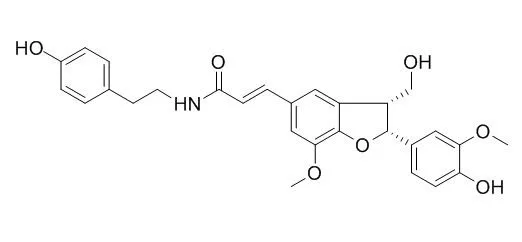Colocasia antiquorum var. esculenta , a variant of C. antiquorum , commonly known as "Imperial Taro", is an edible vegetable in many tropical and subtropical regions of the world.
METHODS AND RESULTS:
This study with the aim of evaluating the potential of C. antiquorum var. esculenta as a functional food with a depigmenting effect resulted in the identification of a new sesquilignan, named colocasinol A (1), and a new acyclic phenylpropane lignanamide, named cis-Grossamide K (2), together with 10 known compounds (3-12). The identification and structural elucidation of these compounds were based on 1D and 2D nuclear magnetic resonance (NMR) spectroscopic data analysis as well as high-resolution fast atom bombardment mass spectrometry (FABMS) and electron impact mass spectrometry (EIMS). Quantitation of the melanin contents and cell viability in murine melanocyte melan-a cells was used to assess the antimelanogenic activities of the isolated compounds.
CONCLUSIONS:
Among them, cis-Grossamide K (2), isoamericanol A (3), americanol A (4), 2-hydroxy-3,2'-dimethoxy-4'-(2,3-epoxy-1-hydroxypropyl)-5-(3-hydroxy-1-propenyl)biphenyl (5), and (-)-pinoresinol (6) showed inhibitory effects on melanin production. Compounds 2, 5, and 6 exerted a particularly strong antimelanogenic activity on the cells without high cell toxicity (IC(50) = 54.24, 53.49, and 56.26 microM, and LD(50) = 163.60, 110.23, and >500 microM, respectively). |






 Cell. 2018 Jan 11;172(1-2):249-261.e12. doi: 10.1016/j.cell.2017.12.019.IF=36.216(2019)
Cell. 2018 Jan 11;172(1-2):249-261.e12. doi: 10.1016/j.cell.2017.12.019.IF=36.216(2019) Cell Metab. 2020 Mar 3;31(3):534-548.e5. doi: 10.1016/j.cmet.2020.01.002.IF=22.415(2019)
Cell Metab. 2020 Mar 3;31(3):534-548.e5. doi: 10.1016/j.cmet.2020.01.002.IF=22.415(2019) Mol Cell. 2017 Nov 16;68(4):673-685.e6. doi: 10.1016/j.molcel.2017.10.022.IF=14.548(2019)
Mol Cell. 2017 Nov 16;68(4):673-685.e6. doi: 10.1016/j.molcel.2017.10.022.IF=14.548(2019)